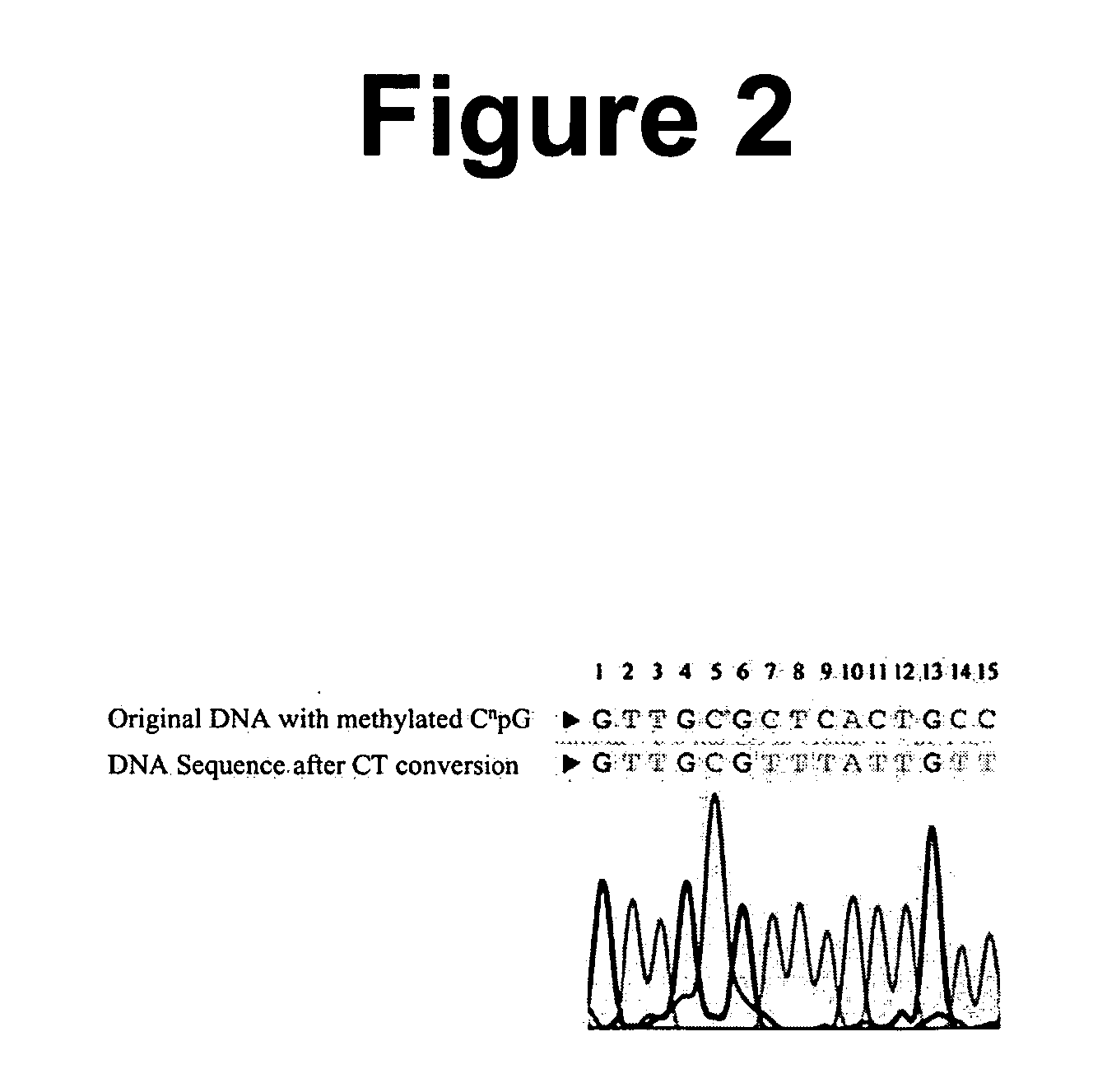Methods for detection of methylated DNA
a methylated dna and detection method technology, applied in biochemistry apparatus and processes, organic chemistry, sugar derivatives, etc., can solve the problems of reducing the overall affecting the efficiency of the enzyme, and requiring significantly more processing time, so as to facilitate denaturation and save significant time , the effect of increasing the overall efficiency
- Summary
- Abstract
- Description
- Claims
- Application Information
AI Technical Summary
Benefits of technology
Problems solved by technology
Method used
Image
Examples
example 1
[0100] Diagnostic Primers
[0101] The primer pair A (SEQ. ID. NO: 4 and 5) are used to amplify a 470 bp DNA fragment from the pUC19 plasmid by PCR (Genbank Acession No. L09137), when unmethylated cytosine (C ) is not converted to uracil (U) (see FIG. 3).
[0102] The primer pair B (SEQ. ID. NO: 6 and 7) are used amplify a corresponding 470 bp DNA fragment from pUC19 by PCR when C is converted to U.
Set A:Seq I.D. No. 5:208-229 nt, Plus sense to amplify originalsequence.5′-gatgcgtaaggagaaaataccg-3′Seq I.D. No. 6:648-667 nt. Minus sense to amplify originalsequence.5′-cgcctctccccgcgcgttggc-3′Set B:Seq I.D. No. 7:B1: Plus sense, primers for use after C to U / Tconversion.5′-gatgtgtaaggagaaaatattg-3′Seq I.D. No. 8:B2: Minus sense, primer after C to U / T conversion5′-cacctctccccacacattaac-3′
[0103] Bisulfite conversion can be monitored using primer pair sets A and B. Primer set A detects unconverted DNA, whereas primer set B detects bisulfite-converted DNA where base C has been converted to U (...
example 2
[0104] Reagents, Solutions, and Buffers
[0105] Bisulfite Reagent (Solution): The bisulfite conversion reagent for approximately 10 reactions is a solid mixture of about 475 mg sodium metabisulfite (Na2S2O5, 1.9 M) and 0.5 mg hydroquinone (4.6 μM). It is recognized that sodium bisulfite and similar bisulfite salts may be used at concentrations from about 0.2 M to about 1.0 M, or about 1.0 M to about 2.0 M. In addition, the antioxidant hydroquinone may be omitted, or alternately used from about 3.0 μM to about 10 μM, or about 4 μM to about 5 μM. The dry chemicals are dissolved by adding 900 μl H20, 50 μl of 50% DMF, and 300 μl of 2 M NaOH. The solution is mixed until the chemicals are completely dissolved. Vortexing or shaking is recommended. Many compositions of bisulfite conversion reagent are known in the art. It is not thought that minor variations in the concentrations or inclusion of specific additional chemical components, other than bisulfite, significantly affect conversion e...
example 3
[0113] Combined Thermal Denaturation and Bisulfite Conversion: Coupled to In-Column Desulfonation.
[0114] The bisulfite conversion and desulfonaton (C-U) of DNA is accomplished using the following protocol. The Reaction volumes may be scaled as required (see embodiment 1, FIG. 1). Step 1: A sample of 130 μl of the nearly saturated bisulfite solution from Example 2 is added to about 20 μl of DNA sample in a 250 ul tube (suitable for PCR reactions). For example: 4 μl DNA sample, 16 μl H2O, and 130 μl bisulfite conversion solution constitutes a standard reaction, though modifications to account for DNA sample volume can readily be made. The DNA sample may contain from about 500 pg to about 2.0 μg of DNA template, and preferably between about 200 ng to about 500 ng. The sample may also contain about 500 ng of salmon sperm DNA or other non-interfering DNA carrier. The sample is mixed by hand by flicking the tube, or other convenient means. The sample is placed in a thermal-cycler device ...
PUM
| Property | Measurement | Unit |
|---|---|---|
| Temperature | aaaaa | aaaaa |
| Temperature | aaaaa | aaaaa |
| Temperature | aaaaa | aaaaa |
Abstract
Description
Claims
Application Information
 Login to View More
Login to View More - R&D
- Intellectual Property
- Life Sciences
- Materials
- Tech Scout
- Unparalleled Data Quality
- Higher Quality Content
- 60% Fewer Hallucinations
Browse by: Latest US Patents, China's latest patents, Technical Efficacy Thesaurus, Application Domain, Technology Topic, Popular Technical Reports.
© 2025 PatSnap. All rights reserved.Legal|Privacy policy|Modern Slavery Act Transparency Statement|Sitemap|About US| Contact US: help@patsnap.com



